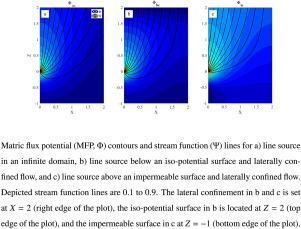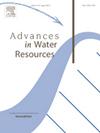Unveiling air sparging analysis in flow cells through the continuum approach
IF 4
2区 环境科学与生态学
Q1 WATER RESOURCES
引用次数: 0
Abstract
We present various analytical solutions for a two-dimensional steady air source that demonstrate classical flow physics’ usefulness in air-sparging evaluation. These solutions capture different flow geometry and setup effects while offering accuracy, speed, and a deeper understanding of governing physics. Compared to empirical models, they excel with fewer physical parameters. We validate their accuracy by comparing these solutions to experimental air-sparging data from two-dimensional flow cells. This comparison underscores the applicability of the physical model and establishes a relationship between grain size and a key model parameter. Furthermore, this analysis enables predictive capabilities for scaled-up systems with diverse setup geometries.
Plain Language Summary Air-sparging refers to the injection of air below the groundwater table, that is, to the water-saturated section of the aquifer. Air-sparging is used to facilitate the volatilization of organic pollutants (e.g., solvents, gasoline) and their extraction to the soil surface. However, evaluating and modeling the flow and distribution of air is limited by the complicated physics of unstable multiphase flow. These complexities drive researchers to search for empirical relations and rules of thumb to design air-sparging systems. In this research, we use previously published experimental data to demonstrate the capabilities and discuss the limitations of the classical physical solutions of steady single-phase flow to evaluate air flow through wet porous media such as aquifers.

通过连续方法揭开流动池中空气喷射分析的神秘面纱
我们介绍了二维稳定气源的各种分析解决方案,展示了经典流动物理学在空气喷射评估中的实用性。这些解决方案捕捉到了不同的流动几何形状和设置效果,同时提供了精确度、速度和对控制物理的更深入理解。与经验模型相比,它们在物理参数较少的情况下表现出色。我们将这些解决方案与来自二维流动单元的实验性空气喷射数据进行了比较,从而验证了它们的准确性。这种比较强调了物理模型的适用性,并确定了粒度与模型关键参数之间的关系。此外,这项分析还为具有不同设置几何形状的放大系统提供了预测能力。空气喷射用于促进有机污染物(如溶剂、汽油)的挥发,并将其提取到土壤表面。然而,由于不稳定多相流的物理过程十分复杂,对空气流动和分布的评估和建模受到限制。这些复杂性促使研究人员寻找经验关系和经验法则来设计空气喷射系统。在这项研究中,我们利用以前公布的实验数据来证明稳定单相流经典物理解决方案的能力,并讨论其局限性,以评估空气在含水层等湿多孔介质中的流动情况。
本文章由计算机程序翻译,如有差异,请以英文原文为准。
求助全文
约1分钟内获得全文
求助全文
来源期刊

Advances in Water Resources
环境科学-水资源
CiteScore
9.40
自引率
6.40%
发文量
171
审稿时长
36 days
期刊介绍:
Advances in Water Resources provides a forum for the presentation of fundamental scientific advances in the understanding of water resources systems. The scope of Advances in Water Resources includes any combination of theoretical, computational, and experimental approaches used to advance fundamental understanding of surface or subsurface water resources systems or the interaction of these systems with the atmosphere, geosphere, biosphere, and human societies. Manuscripts involving case studies that do not attempt to reach broader conclusions, research on engineering design, applied hydraulics, or water quality and treatment, as well as applications of existing knowledge that do not advance fundamental understanding of hydrological processes, are not appropriate for Advances in Water Resources.
Examples of appropriate topical areas that will be considered include the following:
• Surface and subsurface hydrology
• Hydrometeorology
• Environmental fluid dynamics
• Ecohydrology and ecohydrodynamics
• Multiphase transport phenomena in porous media
• Fluid flow and species transport and reaction processes
 求助内容:
求助内容: 应助结果提醒方式:
应助结果提醒方式:


